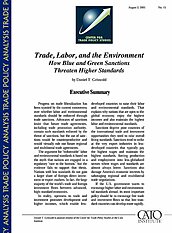The argument for “enforceable” labor and environmental standards is based on the myth that nations are engaged in a regulatory “race to the bottom, but the evidence fails to support that thesis. Nations with low standards do not gain a larger share of foreign direct investment or export markets. In fact, the large majority of the world’s trade and foreign investment flows between advanced, high-standard economies.
In reality, openness to trade and investment promotes development and higher incomes, which enable less developed countries to raise their labor and environmental standards. That explains why nations that are open to the global economy enjoy the highest incomes and also maintain the highest labor and environmental standards.
Sanctions deprive poor countries of the international trade and investment opportunities they need to raise overall living standards. Sanctions tend to strike at the very export industries in less-developed countries that typically pay the highest wages and maintain the highest standards, forcing production and employment into less-globalized sectors where wages and standards are almost always lower. Sanctions also damage America’s economic interests by sabotaging regional and multilateral trade negotiations.
If the U.S. government wants to encourage higher labor and environmental standards abroad, its most important policy should be to encourage free trade and investment flows so that low-standard countries can develop more rapidly.


